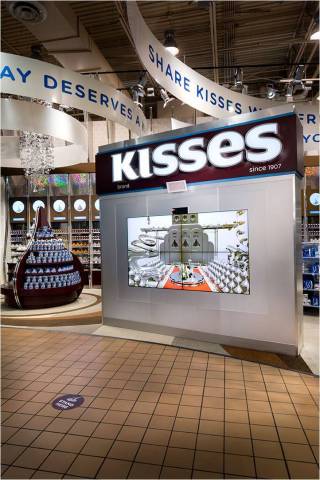
Source: Hershey
As the largest chocolate producer in the U.S., Hershey (HSY 0.66%) is one of the best consumer companies on the market. This is especially true with the consideration of its stellar track record. Hershey has been free cash positive for the past decade, and it did not suffer a loss in any single year of this period. It also grew its top line in every year of the past ten years, notwithstanding the 2008-2009 global economic crisis.
Historically, Hershey has delivered impressive growth numbers as it has expanded its revenues and earnings by 10-year compound annual growth rates of 5.5% and 6%, respectively. However, for a company as dominant as Hershey, which has a 43% market share of the North American chocolate market, does room still remain for growth? Lets compare Hershey with other companies such as Libbey (LBY) and Starbucks (SBUX 3.36%) to understand its future growth drivers.
Pricing power
Growing revenues isn't solely about increasing market share or sales volumes. Price increases represent another key source of growth, provided that a company possesses pricing power. Over the years, Hershey has exhibited its ability to raise prices without this affecting its sales.
In end-2002, Hershey initiated a 10.8% price increase on its standard size, king size, variety pack, and six-pack lines of chocolate products; it raised the wholesale prices of about 50% of its domestic confectionery line in December 2004. More recently, Hershey raised product prices twice in 2008, which resulted in an increase in gross margin from 34.2% in 2008 to 38.7% in 2009. In 2011, it announced a 9.7% weighted-average increase in wholesale prices on the bulk of its product portfolio, which led to the gross margin expanding by 140 basis points to 43% in 2012.
There are two key reasons for Hershey's strong pricing power. Firstly, Hershey boasts a portfolio of iconic brands which are immensely popular with consumers. The 2013 Harris Poll showed that Hershey owns four out of the top eight candy brands favored by consumers, including classics like Reese's Peanut Butter Cups and Hershey's Kisses Chocolate Candy. Secondly, unlike other consumer product categories, private-label products don't pose a significant threat to branded chocolate. Private-label penetration of the U.S. chocolate products category is relatively low at below 5%.
Another company which boasts such strong pricing power is Libbey, the second-largest glass tableware distributor in the world. Libbey increased its gross profit margin from 13.5% in 2008 to 22.8% in 2013. While Hershey's source of pricing power is its brands, Libbey benefits from the low price sensitivity of its customers with respect to its products. Glass beverage-ware tends to make up a small part of the input costs of food-service operators, yet beverages are usually the highest-margin menu items. As a result of this lop-sided cost-benefit trade-off, restaurants are more willing to accept Libbey's price increases on its products.
Looking ahead, the prices of cocoa beans and cocoa butter have increased significantly in recent months, according to Mintec research. The price of cocoa butter rose 65% in March 2014; cocoa bean prices increased by 21% over the same period. Hershey is well-positioned to capitalize on the opportunity afforded by rising input costs to implement product price increases.

Source: Hershey
International expansion
While Hershey is dominant in North America, given its leading market share, Hershey still has opportunities to expand abroad. In 2013, it generated more than 83% of its sales from its domestic operations. However, that could change over time.
According to Euromonitor, China has been one of the fastest-growing retail confectionery markets in the world, as sales increased by a four-year CAGR of 9.8% from $9.6 billion in 2009 to $13.9 billion in 2013. China has been Hershey's second-largest market outside of North America, and the revenue contribution from this market grew by a five-year CAGR of 84% from 2007 to 2012. Hershey's China operations are poised for further growth following the company's acquisition of the Chinese confectionery company Shanghai Golden Monkey in December 2013. Shanghai Golden Monkey has a long history which spans 25 years and is the sixth-biggest Chinese chocolate company with a 1.4% share of the local confectionery market.
Hershey's acquisition of Shanghai Golden Monkey will have two key benefits. Firstly, given the localized nature of consumer preferences, with a local partner Hershey can tailor its products to local consumers' tastes. Secondly, Hershey can leverage Shanghai Golden Monkey's extensive distribution network of 130 sales offices, 1,700 sales representatives, and 2,000 distributors to further expand its sales.
Given that there's always a Starbucks outlet around the corner in the U.S., Starbucks is another dominant domestic brand which has set its eyes abroad. It has already done well in China, where it has a footprint of more than 1,000 stores in close to 70 Chinese cities, after it opened its first store there 15 years ago. However, there are also many markets abroad where Starbucks' penetration rates have stayed low. For example, despite the potential of the India market, Starbucks only has presences in just four cities and about 40 outlets there. Starbucks' international expansion strategy is similar to that of Hershey, capitalizing on the strength of its well-known brand to penetrate more markets.
Foolish final thoughts
Hershey reported a disappointing set of results for the first quarter of fiscal 2014, growing its net sales by a mere 2.4%. Notwithstanding, Hershey's management reaffirmed its full-year guidance of 5%-7% revenue growth. I am similarly optimistic about Hershey's future growth prospects given its dominant market leadership. Furthermore, I see more growth upside from price increases and geographic expansion plans.




